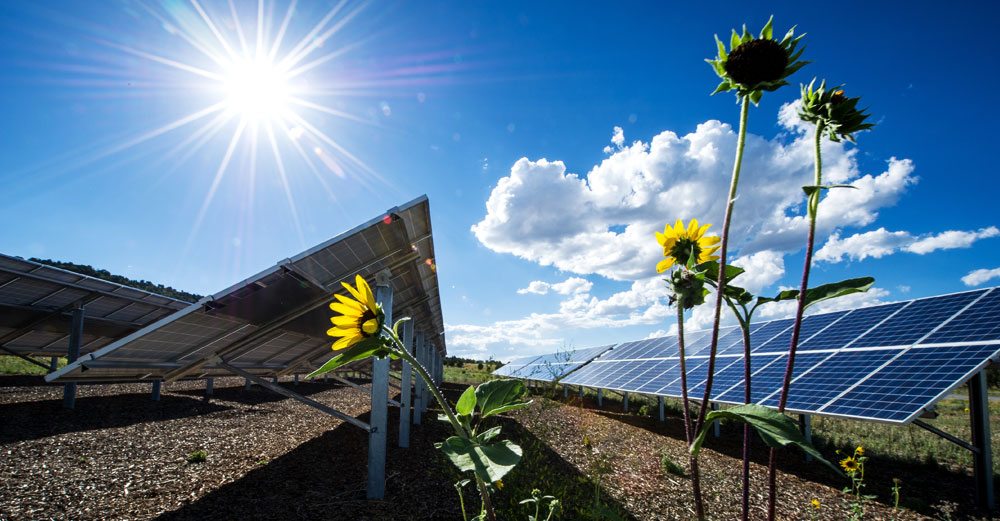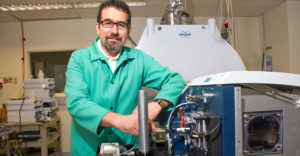
When it comes to fighting climate change, it takes more than a village. It takes scope. It takes scale. It takes collaboration across political borders, academic disciplines, and institutional silos.
Acknowledging this challenge, SUNY partnered with research universities representing the United States, Canada and Mexico to pool resources and spur climate action across the continent. The thirteen universities formed an international consortium dubbed the UC3, for University Climate Change Coalition.
The core of the UC3’s mission is to integrate the universities’ research and resources to tackle the twin problems of climate change mitigation—reducing greenhouse gas emissions in accordance with the Paris Accords—and adaptation to changes that are already occurring. The consortium’s shared knowledge will be used to develop solutions-based climate action plans with local businesses and governments.
In 2016, the U.S.-based members of UC3 together performed about one-quarter of the environmental science research conducted by all U.S. institutions, according to data collected by the National Science Foundation (NSF). SUNY researchers are finding energy alternatives to fossil fuels, creating long-lasting batteries, fighting climate-related diseases, even re-visioning how we draw maps to reflect what is happening to our world.
Ongoing work to create a cleaner future
Edmund Chang, one of four Stony Brook University professors who shared the 2007 Nobel Peace Prize with former Vice President Al Gore for their work on climate change, is now working on improving long-range forecasting. He is testing prediction models that will help push the window of accuracy from the current standard of about 10 days to a month or more. That can give governments and industries — especially utilities, transportation and agriculture — more time to prepare.
Minghua Zhang, who shared the 2007 Nobel Peace Prize, is working with political scientist Oleg Smirnov to forecast the social impacts of climate change. The researchers found that if emissions continue unabated, the number of people exposed to extreme drought – who may have to migrate — will increase by more than 400 percent by the end of this century.
Stony Brook chemistry professor Jin Wang and physics graduate student Zhedong Zhang discovered a mechanism in the energy transfer process of photosynthesis that could help to make sustainable solar energy a reality. In plants, pigments are held in place by proteins, a structure known as the pigment-protein complex (PPC). During photosynthesis, the pigments absorb light, and the energy is carried to centers where photosynthesis occurs. Wang’s research suggests that due to the strong interactions, the energy carriers are screened by the discrete vibrations of PPC. This process shields the energy carriers from the environmental influence. Together with nonequilibrium environments, this greatly enhances energy transport.
Also at Stony Brook, Esther Takeuchi, the William and Jane Knapp Chair in Energy and the Environment, received a $10 million award from the Department of Energy to continue her research into high-power, long-lasting energy storage systems. She and her team of chemists, material scientists, electrical engineers, and physicists are investigating magnetite in order to produce a battery that is three times more effective and more environmentally friendly than current storage systems.
The Department of Energy also awarded $12.8 million to the NorthEast Center for Chemical Energy Storage at Binghamton University, which is directed by M. Stanley Whittingham, a pioneer in the Development of lithium ion batteries. Whittingham and his colleagues want to understand the fundamental chemical reactions in energy storage materials to make them work better and to develop new materials that are cheaper, environmentally friendly and able to store more energy than current materials can.
Climate change affects the entire planet and University at Albany faculty and students are conducting research around the globe. Professor Mathias Vuille is merging data from tree-ring and cave sediment archives in South America to produce reconstructions of historical extreme weather. Associate professors Jiping Liu and Liming Zhou are studying the impact Arctic sea ice loss and a 17-year drought in the Congo Rainforest, respectively. NSF CAREER grants are supporting Justin Minder’s research on the Rocky Mountains’ shrinking snow pack and Brian Rose’s work to understand the fundamental effects of ocean heat fluxes on the Earth’s atmosphere and climate system. Professor Aiguo Dai was recently named a Fellow of the American Meteorological Society for his extensive research dealing with much of the Earth’s climate system, including interactions of its many different components. A team of faculty and student researchers are studying typhoons and other extreme weather in Taiwan with funding from an NSF PIRE (Partnerships for International Research and Education) grant.
Clouds are an important area of study in climate change; depending on their composition, they can either reduce or amplify global warming by absorbing or reflecting shortwave radiation from the sun and trapping longwave radiation emitted from the earth. At the University at Albany’s Atmospheric Sciences Research Center, professors Wei-Chyung Wang, Qilong Min, Fanqun Yu, Sara Lance, Sarah Lu, along with student research assistants Guoxing Chen and Yangyang Song are studying how manmade pollution affects the composition of clouds and how that might contribute to rising temperatures.
To investigate the effects of climate on Zika and other mosquito-borne diseases, Dr. Anna Stewart-Ibarra, assistant professor of medicine and director of the Latin America Research Program at Upstate Medical University, has established a long-term research and training platform in southern Ecuador in partnership with that nation’s Ministry of Health. There, Dr. Stewart-Ibarra and her colleagues are studying the effects of climate on disease transmission and how local social-ecological conditions affect disease transmission risk. They are developing new tools that use climate forecasts to predict disease epidemics, which can help officials determine when and where they should direct disease control efforts. The research platform has been funded by the National Science Foundation, the US Department of Defense and the US Centers for Disease Control, among others.
Climate change affects the health of other species, too. Howard Lasker, professor of geology at the University at Buffalo, led an NSF-funded research trip to St. John to assess the damage that Hurricanes Irma and Maria did to coral reefs. Lasker discovered that the massive hurricanes cloaked coral colonies with algae, ripped off branches, and scraped off the microscopic animals that make up the reef, leaving open wounds that became infested with bacteria. By cataloguing the damage, Lasker hopes to understand how the reefs—which support fish and wildlife that feed thousands of ocean side communities—recover.
And then there’s the effect of climate change on our natural resources. According to the EPA, climate change is likely to increase water demand and shrink water supplies, threatening the availability of clean drinking water. David C. Richardson, associate professor of biology at SUNY New Paltz, has been collecting temperature data on more than 200 lakes in the northeast U.S. and southeast Canada. His alarming findings confirm the EPA’s prediction: about 90 percent of the lakes he surveyed showed surface warming, creating conditions for algae blooms that make the water undrinkable and killing off cold water fish like trout.
All of which suggests that we need new ways of looking at our world. At Buffalo State, Stephen Vermette, a professor in the Geography and Planning Department, has redrawn the map of western New York, dividing the eight-county region into five climate zones. By analyzing existing climate trends, Vermette hopes to help government infrastructure, businesses, and local agricultural concerns better prepare for changes that are already happening.
A system-wide effort
In addition to the consortium’s core goal of sharing knowledge and resources, each consortium member has pledged to model climate action by reducing its own carbon footprint. With 64 campuses, 600,000 students, and 40% of New York State-owned buildings, SUNY’s energy demands are greater than every other university system in the country. Under Chancellor Johnson’s plan, SUNY will source 100 percent of its electricity from zero-net-carbon sources as soon as possible, partnering with local government (NYSERDA) in the process.
Why now? The urgency of flooding and fire. Shorter winters and rising sea levels. And universities themselves have changed in the past ten years. An overreliance on federal funding, combined with a current dearth of federal support, has inspired them to work with local governments and businesses in new ways. Increased connectivity allows them to work across platforms. And growing favor for multidisciplinary approaches has led thought leaders to acknowledge that climate change research needs to come from multiple perspectives —not just science but also economics, sociology, public policy. As Samuel L. Stanley, President of SUNY Stony Brook, said at the unveiling of the UC3, “Climate change is not purely a technical problem. It’s not going to be solved purely by technical means.”
Most fundamentally, the problem is simply too big to tackle alone. By drawing on each other’s expertise, consortium members have already begun to find new ways of thinking about their own particular challenges. Chancellor Johnson modeled this reality when she announced that SUNY would be joining the UC3, saying, “Sustainability is a shared responsibility. By joining the coalition with other leaders in higher education, we take that effort international.”




Happy to see that people are working to provide a Low-Carbon Future. Good luck for the good work. Thank you.
SUNY is always ahead of the curve when it comes to stuff like this.
This is really great! I’m glad people are working on this!
That’s really great that SUNY Is working on it! Hope others follow suit
“Sustainability is a shared responsibility. By joining the coalition with other leaders in higher education, we take that effort international.”
This absolutely needs to be an international effort and quickly!
I am very concerned about the future of the world, and how the environment is reacting to the way humans have treated it.
Hopefully the top minds will find a way of reversing this trend…
Environmental change is something that will impact us all, the more and more extreme fluctuations of weather is concerning. Here in Chicago, we got -20 without even taking into account windchill last month!
Hopefully we can use some machine learning and self improving AI to develop cutting edge pollution reversing technologies.
Amazing that 90% of the lakes surveyed showed warmer surface temperatures. Thanks for the good read and helping make the world a better place a little bit at a time.
Wow that’s kinda crazy to think that just due to the UC3 coming together it boosted Americas environmental science research by 25%, that’s what i call making a serious difference in the world. Thank you guys for fighting the battle many people don’t even know exists, keep up the hard work!